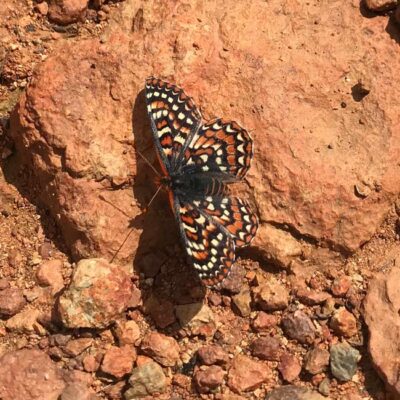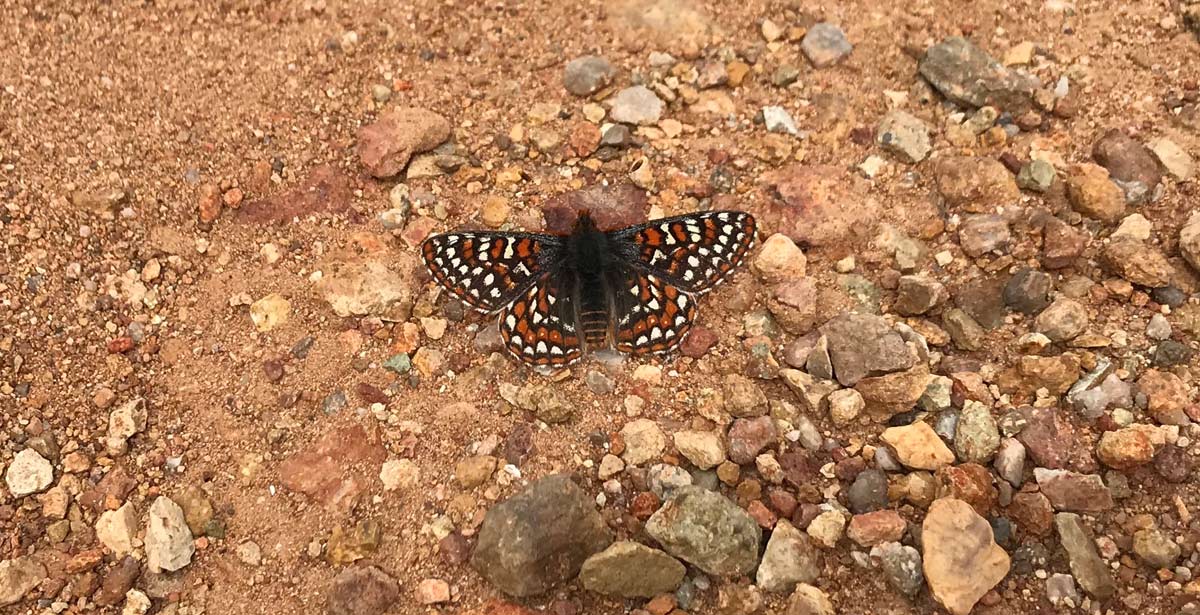QUINO CHECKERSPOT BUTTERFLY
Euphydryas editha quino
Status: Federally Endangered
Recovery Permit Required for Surveys? Yes
USFWS Protocol Surveys Required? Yes
Range: Southern California and northwestern Mexico
Link: USFWS Survey Guidelines
The Quino checkerspot butterfly (QCB) is a small (up to 3cm), brown, red, orange and black butterfly that is native to southwestern California and northwestern Mexico, found in open grassland and open chaparral habitats. Several SummitWest employees hold the USFWS recovery permit required to conduct protocol presence/absence surveys for Quino, and have combined over 15 years of experience with the butterfly and its host plants and nectar sources.
SUITABLE HABITAT
 The Quino checkerspot butterfly occupies a small geographic range in select areas of southern California and northern Mexico. It is found in San Diego, Los Angeles, Riverside, San Bernardino, Orange, and Imperial Counties. The quino checkerspot butterfly has a unique life habit, being that caterpillars go through diapause and can last through several seasons. A good rain year in 2018 might not necessarily mean a good flight season; it may not be until 2019 or 2020 that the caterpillars from 2018 emerge as butterflies. Read more about the quino checkerspot butterfly life cycle here.
The Quino checkerspot butterfly occupies a small geographic range in select areas of southern California and northern Mexico. It is found in San Diego, Los Angeles, Riverside, San Bernardino, Orange, and Imperial Counties. The quino checkerspot butterfly has a unique life habit, being that caterpillars go through diapause and can last through several seasons. A good rain year in 2018 might not necessarily mean a good flight season; it may not be until 2019 or 2020 that the caterpillars from 2018 emerge as butterflies. Read more about the quino checkerspot butterfly life cycle here.
Determining suitable habitat for the quino checkerspot butterfly is usually done before surveys begin, and can continue to be refined once surveys have commenced. Understanding what makes habitat suitable can keep your project moving forward and not over-extending the budget.
Quino tend to reside in open margins of scrub habitat where dominant plant species may include California sagebrush (Artemisia californica), chamise (Adenostoma fasciculatum), and non-native/native grasslands where the thatch is not too thick. They prefer mafic soils with cryptogamic crust, but they can be found elsewhere too. There must be larval host plant and suitable nectar sources nearby in order support this species.
Field observations indicate that quino checkerspot butterflies larvae on only a few plants, including Plantago erecta, P. patagonica, Antirrhinum coulterianum, Cordylanthus rigidus and/or Castilleja exserta. On the wing, quino checkerspot butterflies nectar on a variety of spring wildflowers, including Lasthenia californica, Linanthus dianthoflorus, Cryptantha sp., Plagiobothrys sp. (popcorn flowers), Eriophyllum sp. (yarrows), Phacelia sp., Amsickia menziesii (fiddleneck), and other co-occuring species that bloom during the Quino flight season.
Quino will frequently hang out on vegetation or other substrates such as bare ground, rock or dirt roads, to mate, bask or fight for territory, and require open areas with high solar exposure to facilitate breeding and movement. (5 year Review)
SURVEY SEASON
Per the USFWS Quino checkerspot butterfly survey guidelines, the survey season starts during the third week of February and ends on the second Saturday in May. Surveys are to be conducted weekly and no closer than every 4 days. Surveys can only be conducted when weather conditions are proper for flight. Surveys will not be conducted in fog, drizzle, or rain, nor in sustained or gusting winds that average greater than 15 miles per hour. Temperature in the shade must reach at least 60-F on a sunny day with less than 50% cloud cover, or 70-F with 50% or more cloud cover. (USFWS protocol)


